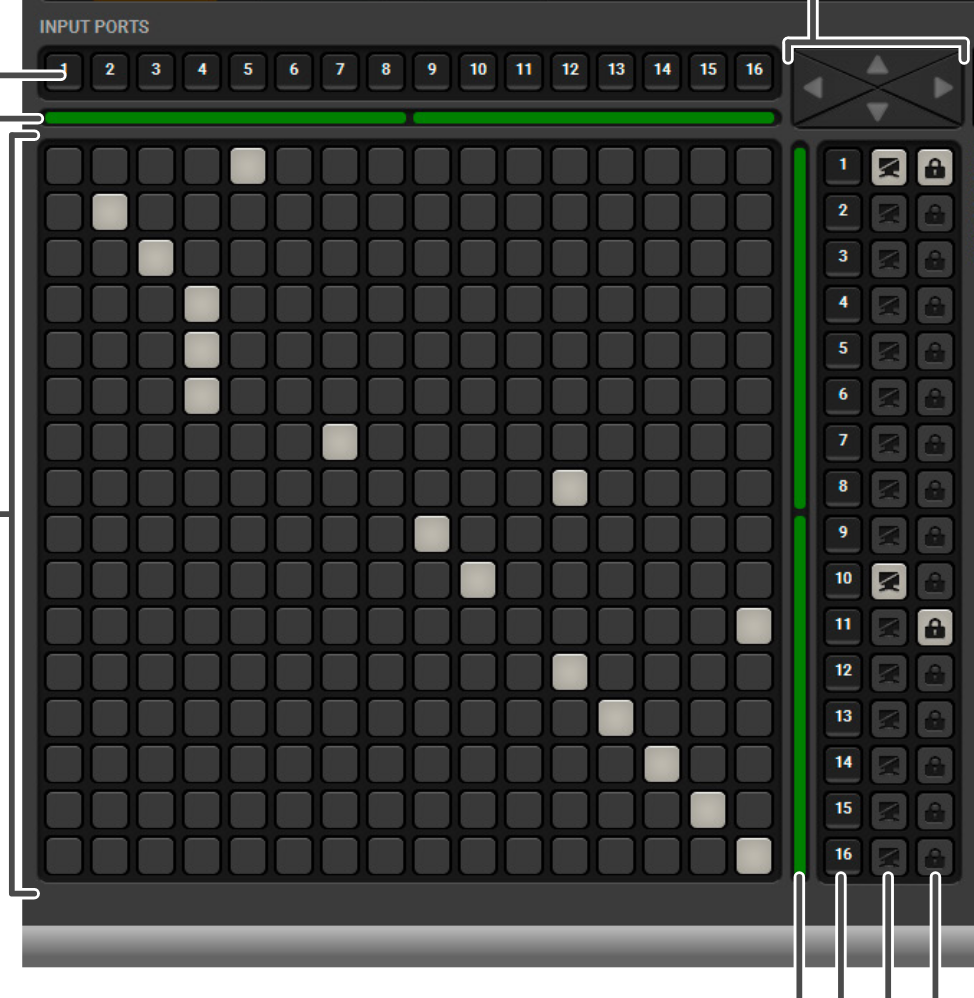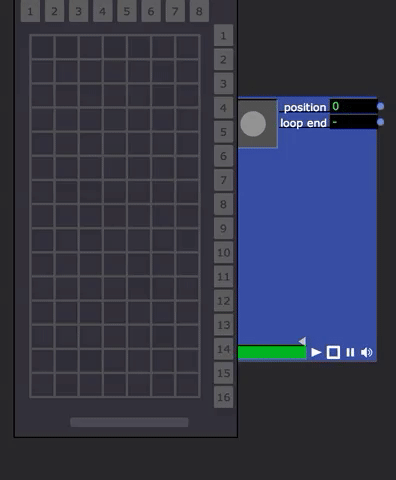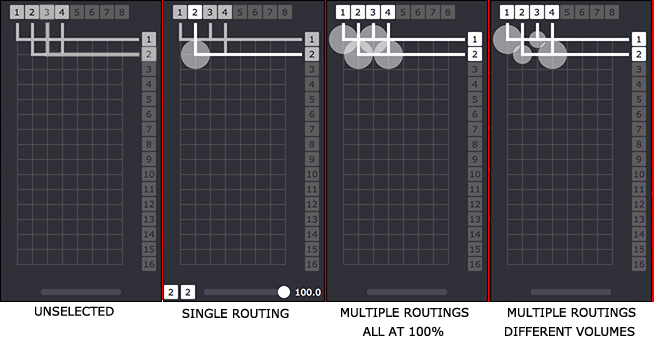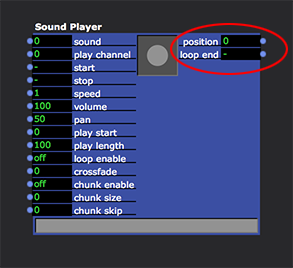Audio Features for Isadora: What Do You Want?
-
I silently followed this threat, as I did always wait for extended audio features to giving Isadora a more complete feeling, but haven't had a specific feature request.
This all sounds very promising!But I now just wanted to extend this a little bit, even if I risk to tell something you already have in mind, as it is to obvious, but I better say than sorry!
For the audio routings you mention multiple inputs to single output in a 'sequential' manner. But shouldn't it be even more important to have the possibility to route one source to several outputs?
This is especially important to keep in mind, when 'building' the graphical based matrix 'cross point view', as it needs the possibility to put multiple crosspoints in one output row.I guess this is the reason, why the most video matrix switchers remotes software that visualize cross points (like Lightware, s. below) are showing inputs and outputs the other way around (inputs on top, outs right).

As I said, maybe you have this in mind already, and it might be just a small thing, but I thought it would be worth mentioning.
kindly
Dill
-
What I really "miss" at the moment is "basic" player with following specs:
- Different formats WAV/AIFF/FLAC
- Different with depths / sample rates
- Multichannel output, but with volume for each routing
- Also multichannel output as one tie line (so going form 8 channel out to 8 channel in another plugin is just one tie line)
Then, behind that the use of audio as control element would be great in different plugins:
- Configurable multichannel/crosspoint mixer (Like Qlab)
- Analyzer
I have also a idea about a recurring "problem" within showontrol environments. I just had a whole conversation with Allen and Heath about this, when I did a showontrol setup with the SQ 5. If you want to make a fade over time, you need a envelope generator/ curvature / scale value, followed by CC send and trigger that CC for every value..... That is really not of this time any more. Because , it is nice for fading a couple of fades, but what if you have let's say 12 channels of audio and 20 mic inputs on your desk and you want to control, you have to make this 32 times..... And if you have a moment you want to do a fade out on all channels to zero, think about the massive overkill on the system and midi commands....I suggested to Allen and Heath a system that defines only the fade time and value and put that in a midi string as command. Then you only send commands and not CC's all the time. That was a great idea, but unfortunately the desks needed a more powerful CPU to do these kinds of controls. It would also save massive time if you want to go "from" a certain value "to" a certain value. (so in this case I always "update" the input of the envelope generator) A lot of work.
So, this conversation with Allen and Heath made me think how can you have a set of controls within Izzy to deal with this, that would save a lot of communicating back and forth:
- A multichannel mixer with volume control but also fade in/out trigger and fade time for in and out, per channel
- Multichannel tie lines
For example, I have a 16 track WAV sound file running with continuous soundscapes that you like to fade in and out at certain moments on selected tracks. In this case you just have 1 player with a 16 channel WAV, 1 multi tie line to the 16 channel mixer and there you can define the controls. let's say channel 1 fade in 0,5 second, but fade out 4 seconds. Just set the fade time and trigger it. Can be done with collapsable controls, because for each channel you have VOLUME/ TRIG FADE IN/ TRIG FADE OUT/ FADE IN TIME/FADE OUT TIME. Would be awesome if the manual volume setting can be altered as well and the command to trigger a fade will run from that value. For rehearsals it is also great.
That solves you playback fades and unfortunately there are no mixing desks at this moment that will do these kinds of processing. It is limited to scene lists, mutes or midi CC.
-
@mark: It sounds very promising what you intend to program for the next level of Isadora! I like every single improvement in the sound features you plan. I also think that the priorities you sketched are very reasonable.
A little note to all the improvements to come: I tried to build a Sound Player that has outputs "position" and "loop end". I know for sure this comes years too late, but anyway: Here is a "Sound Player plus" actor with outputs! It is made on top of the original Sound Player actor, combined with a timer and a couple of Javascript lines. Of course it's not perfect, but it works. It has the same inputs as the original Sound Player, except for the "play length" input, which I changed to "play stop". That helped to make the Javascript file easier.
Maybe one of you has some need for it while Isadora-3.1 is on the way...
-
-
Your plans for 3.1 audio upgrade sound great. I am particularly interested to see the outcome of the interactive audio routing system - because I can already imagine implementing this in my projects.
You haven’t mentioned integrating timecode or a waveform monitor for the Sound Player are either of these features on the cards?
Best wishes
Russell
-
Dear All,
To whet your appetite, this is what I did over the holidays: 24, 16 and 8 bit AIFF or WAV files with any number of channels, and now the new Matrix Routing input shown below. Working well on macOS, now heading for Windows.

Happy New Year (almost)!
Mark -
@mark that is great news !! Happy new year for you too (almost)
Maxi Wille
-
hello,
thank you for holding on while christmastime.
do you think it´s possible to route the "speak text" actor also on windows?
thx.
r.h.
-
@ mark look fantastic.
happy new year
Jean-François
-
@deflost said:
do you think it´s possible to route the "speak text" actor also on windows?
Well, I would have to find a way to intercept the samples and then route them. I doubt that this is easy, which means I cannot assign a high priority to this given that it is a feature that not so many people use. Let's keep it in mind for a future version.
Best Wishes,
Mark -
this would be great, because it´s one of the favorite actors by our kds workshops, they love it to let the machines speak!
thx.
r.h.
-
@deflost said:
this would be great, because it´s one of the favorite actors by our kds workshops, they love it to let the machines speak!
But do they really need to route to to a multichannel output?? Seems a bit sophisticated for kids.
Best Wishes,
Mark -
not really, but sometimes it is a little bit depressing that there is no way to do left right or front back things with it!
thx.
r.h.
-
@deflost said:
not really, but sometimes it is a little bit depressing that there is no way to do left right or front back things with it!
Sorry... I read "kds workshops" as "kids workshops" -- I thought they were workshops for children.
-
you read absolutly right, children. the most of them are around 8 to 12 or 16 to 20, we work a lot
with them in a cooperation with their schools.
we do every kind of "new media" stuff with them.
so in some situations, in special for theatre like performance stuff, they are very accurate
with things that have to be logic. so when they want to let the machine speak out come in,
then please from the right side, and when the bad witch calls from back outside the building, then of course they ask
why we don´t use bluetooth or something like that.........and so on.
but so they learn much about physical audio mixing consoles and this kind of stuff.
so another thx for your work.
r.h.
-
Dear All,
I hope you're enjoying your jump into 2020.
I'm exploring if and how the volume at the crosspoints of the Matrix Router should be displayed. On one hand, it's handy to see it and for sure when you are adjusting the volume, the circle getting biggger/smaller gives you strong visual feedback about which item you're editing. For sure, when no routings are selected the volume circles should not be shown. But maybe it gets too cluttered when you make a multiple selection? I could make it so that the volume circle only shows when there a single routing is selected.
I'd be curious to hear your reactions.

Also, as you can see, I've gotten this to be this to be bit more compact than you saw in the first GIF I shared before. But I can also anticipate that having more than 16 channels of output is going to make for a very tall user interface element... do people use more than 16 channel output devices on a regular basis?
Best Wishes,
Mark -
Hi Mark, Happy New Year!
Here's a thought: that the squares that are the numbers across the top grow into rectangles to indicate the volume level. They could even change colour, just like a VU meter!
Cheers,
Hugh
-
@citizenjoe said:
Here's a thought: that the squares that are the numbers across the top grow into rectangles to indicate the volume level. They could even change colour, just like a VU meter!
Thank you... intersting idea. The disadvantage being, if you are routing the same channel to many outputs, you wouldn't know the individual volumes for each output.
Best Wishes,
Mark -
-
@mark I prefere numerical values (dB) shown close to output number box, is more precise in professional enviroment where gain structure is foundamental.
